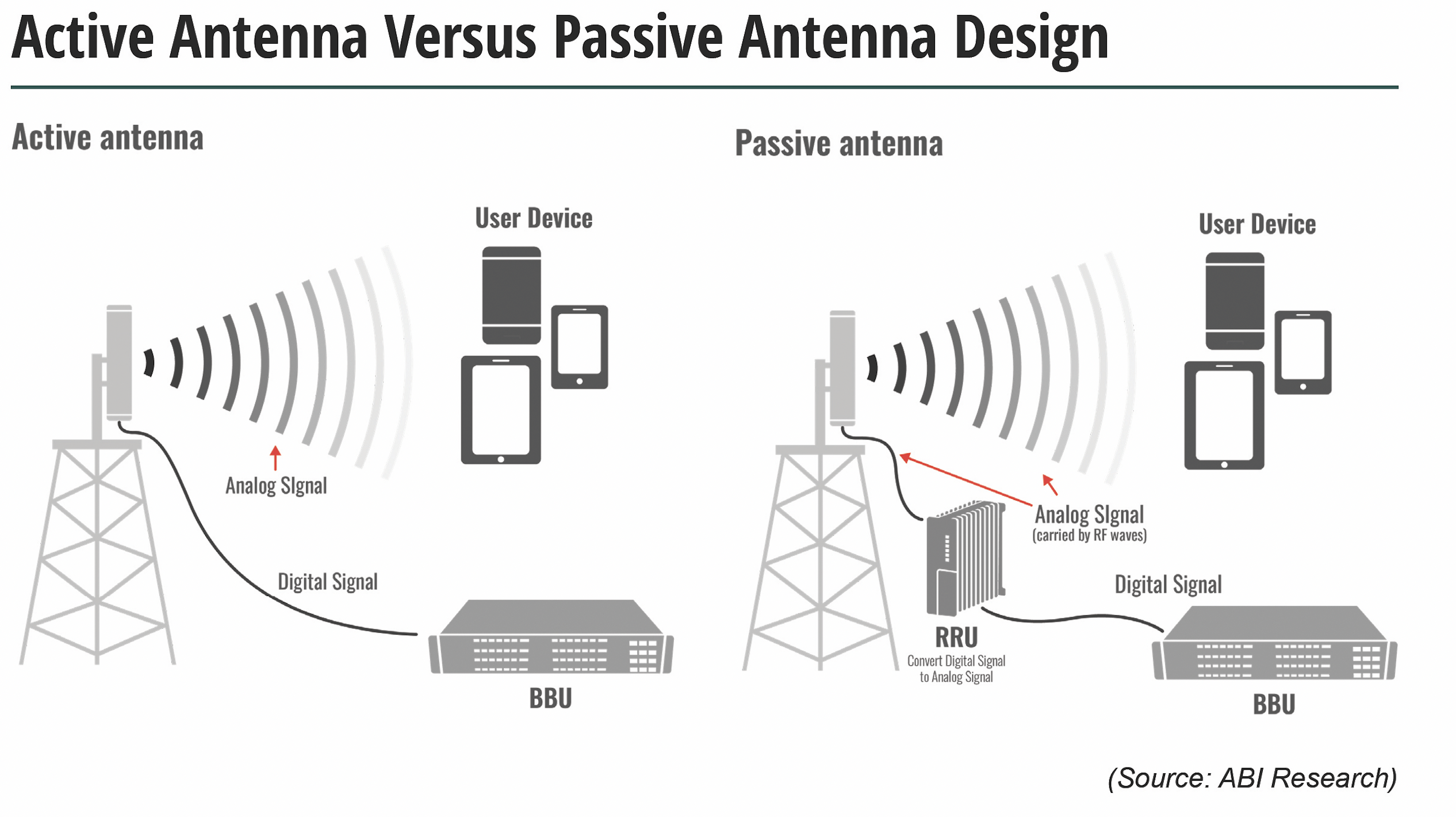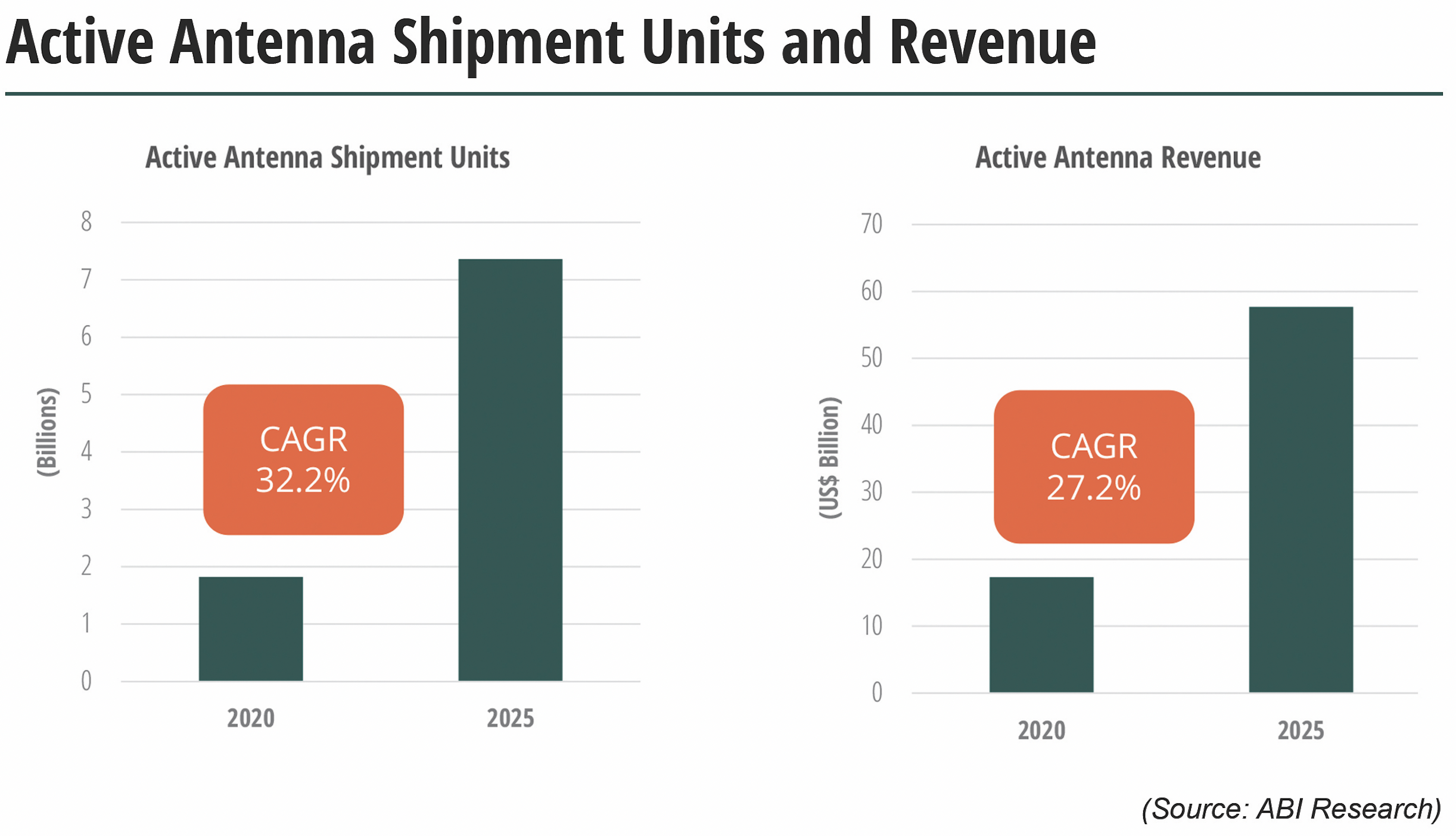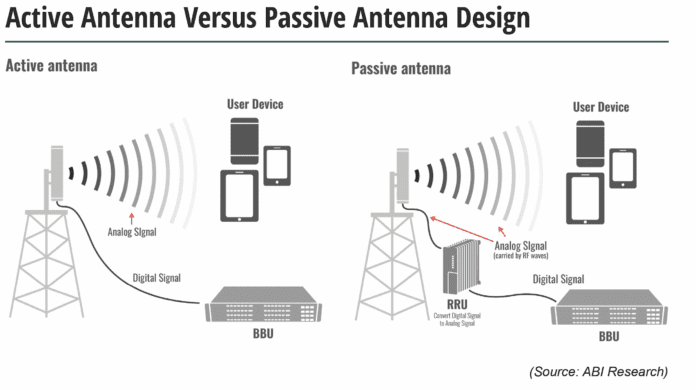The base station antenna is an increasingly complex and essential part of the mobile network as networks evolve to 5G. The evolution from 3G to 4G and now to 5G has enabled increasing sector throughput rates and it is the base station antenna that has to hand off the traffic to the airwaves. The rollout of 5G mobile networks in the 3.5 GHz band (C-band) has highlighted the importance of active antennas, in particular Massive Multi-Input Multi-Output (MIMO) active antennas, to deliver the data throughput performance in terms of capacity expansion, ultra-precise beamforming, and individual end-user throughput. Three-Dimensional (3D) beamforming, which can provide high gain and steerable beams, not only improves signal coverage but also reduces costs due to the subarray requiring less power and less costly high-power amplifiers. ABI Research forecasts world-wide mobile data traffic to reach 2,700 exabytes annually by 2025. As data traffic increase exponentially, ABI Research expects active antennas to become an increasingly important tool for Communication Service Providers (CSPs).
The telecommunications industry including Original Equipment Manufacturers (OEMs), such as Ericsson, Huawei, Nokia, and ZTE, as well as standards organizations, and industry associations, such as the Institute of Electrical and Electronics Engineers (IEEE), ITU Radiocommunication Sector (ITU-R), 5G Americas, and NGMN Alliance, have contributed to the development and standardization of active antennas. Based on the contributions that are currently available from industry stakeholders, there has been a broad range of definitions used for what an “active antenna” represents. In terms of terminology, active antennas have variously been written as “Active Base Station Antenna,” “Active Antenna System,” “Advanced Antenna Systems,” or just “Active Antenna.” ABI Research feels it was necessary to clearly define and differentiate between active and passive antennas for a consistent terminology and reference across the industry.
What is an Active versus Passive Antenna?
Organizations such as the 5G Americas have defined active antennas as “integrated radio and antennas,” whereas the NGMN Alliance have defined active antenna system (AAS) as an antenna that also contains active electronic components in addition to passive components that can be found in passive antennas. Reviewing the various definitions from stakeholders in the telecommunications industry, it is clear that an active antenna is an antenna which requires integration between the passive antenna and active elements (such as radio units/transceivers, amplifiers, and baseband). The differentiation between active antenna and passive antenna is further accentuated by analyzing the vendor-CSP value chain, components, and functions.
Value Chain
Typical base station antenna value chains involve three parties: 1) CSPs, 2) OEMs, and 3) antenna manufacturers. For a passive antenna, CSPs can either acquire antennas from base station antenna manufacturers directly and then separately acquire the rest of the base station equipment or purchase a turnkey base station solution from the OEMs, which includes both the passive antenna and base station equipment. In the case of active antennas, it is necessary for OEMs to purchase passive antenna components from antenna manufacturers and integrate them with their own “active” electronics radio units. As a result, CSPs can only purchase active antennas from OEMs.
Components
It is also worthwhile to understand how active and passive antennas differ based on the components within the antenna radome. In a passive antenna design, the remote radio unit (RRU), which houses the transceivers and the amplifiers (Radio Frequency Power Amplifier and Low-Noise Amplifier), is separately mounted on the tower connected to the passive antenna via feeder cables and via optical fiber to the baseband unit. For an active antenna, the transceiver array as well as the amplifiers can be found within the radome as the RRU is integrated with the passive antenna components. Furthermore, components such as filters and shielding covers are used to minimize or prevent interference.
Figure 1: Active versus Passive Antenna Design

Functions
Another differentiating factor between passive and active antennas is the operational functions which the antenna can perform. An active antenna can both amplify and convert radio frequency waves in addition to signal radiation and reception. This is due to the integration of active components from the RRU with the passive antenna. On the other hand, a passive antenna can only radiate and receive the radio frequency waves over the air interface.
In terms of deployment and implementation, passive antennas have been historically deployed for 2G, 3G, 4G, and 5G in rural, suburban, but also urban areas. However, especially for 5G technology, active antennas are more suited to be deployed in both urban and dense urb
an areas due to the high population density, high data consumption, demand for high throughput, space constraints, and challenges arising from high-rise buildings.
Market Drivers and Inhibitors
The use of active antennas can provide enhancements to CSPs’ operations through lower operational costs from more efficient networks while producing an optimal user experience. Apart from the benefits of active antennas, there are some market factors that can further drive their adoption. These include the increased access to spectrum asset bands such as the 3.5 GHz band, the expanding global cellular data traffic demand, active antenna’s technological advantage in delivering reduced latency and improved energy efficiency, massive MIMO capabilities, development of solutions to overcome physical cell site space limitations, and the implementation of more cost effective and power efficient signal processing algorithms.
There are, however, certain potential inhibitors that are important to note. On the technological end, the occurrence of pilot contamination can limit the actual throughput achieved while also posing a challenge when it comes to channel estimation. There is also the added interference caused by the large number of Massive MIMO radio antennas, as well as various other user equipment (UEs) transmitting signals along different transmission paths. On the market front, the choice of frequency bands, cost of active antenna products with large number of antenna array combinations (e.g., 32T32R or 64T64R), and cell site technical aspects in the form of physical space, power supply, and wind load requirement, are considerations that have to be factored into the implementation of active antennas.

Despite the technological and market inhibitors, active antennas, in particular Massive MIMO active antennas, are crucial in realizing the potential of 5G with its beamforming capabilities and in achieving enhanced spectral efficiency. ABI Research expects active antenna shipment units to reach more than 7.3 million in 2025, growing at a CAGR of about 32.2%. Active antenna revenues are forecasted to reach approximately US$56 billion by 2025, growing at a 5-year CAGR of 27.2% from 2020 to 2025. The average cost of active antenna will continue to come down, which will drive up sales in the short- to mid-term, but sales volume is expected to taper around 2025.
In summary, active antennas have the capabilities to further enhance 5G deployments and enrich experiences for customers. In addition, the potential growth of the active antenna market presents an opportunity for industry organizations, CSPs, OEMs, and other stakeholders to facilitate and capture that growth. However, it is important for the telecommunications industry to have a common and standardized definition of what constitutes an “active antenna” and how it differs from a “passive antenna.” This will improve integration and implementation while speeding up widespread adoption of active antennas.

